We’d like to thank Shilpi and Amit Mehta for hosting the potluck dinner last night. My talk was on “Common Pitfalls of Paleo,” and it was a pleasure to meet so many Paleo enthusiasts, including people we knew from PaleoHacks, email, comments, and Facebook.
We brought pumpkin soup to the potluck, and that will be our food post this week. But we’ve had some questions about bone broths, so let’s revisit that first.
Making a Tasty Broth
Earlier, we discussed making a broth from ox feet (Ox Feet Broth, Miso Soup, and Other Soups, Jan 2, 2011). The advantage of feet (ox feet, chicken feet) or tails (ox tail) is that they have a lot of connective tissue, so they make a gelatinous broth full of nourishing collagen.
However, you can make a good broth from any bones, and it’s possible to find marrow bones that also have some connective tissue. With longer cooking, you can extract collagen and minerals from the bone itself, and get a good broth from these larger bones.
We’ve found, on limited data so far, that bones from grass-fed animals from local farms seem to produce a tastier broth than supermarket bones. I’d be curious to hear if others have had the same experience.
A few other tricks can help make a tasty broth. One tactic that seems to work is to discard and replace the cooking water at an early stage.
Here’s what we do. In this case, we started with a mix of beef and pork bones:
As you can see some blood comes out of the bones, especially the pork bones, almost immediately. This may be responsible for the poor taste some experience.
We put the heat on very low and let the water warm up gradually. Before it reaches a boil, after an hour or less, it looks like this:
At this point we drain and discard the liquid, adding new water. It now looks like:
You can see the marrow inside the pork bones, which will fall out before we’re done, and the ligaments and tendons in the joints, which will produce a nourishing gelatin. Bits of meat and fat will also be released.
After some hours of cooking, all the meat and fat and most of the marrow and connective tissue will have fallen off the bones. It will look something like this:
At this point you can pour out the broth into a container and use this fatty, meaty broth for rich soups. Seaweed, vegetables like tomatoes and onions, and thinly sliced beef, tendon, or pork bellies go well with this broth. We often use it for Pho (Vietnamese Noodle Soup) (Feb 27, 2011).
Add water and acid and continue cooking. This second round of broth will mainly contain minerals and some collagen, and will need longer cooking.
In the second and later rounds of cooking, we add an acid to help extract minerals from the bones and expose the collagen matrix. Lime juice, lemon juice, and vinegar all work well. We especially like the juice of a lime, and rice vinegar, which gives a slightly sweet taste; others seem to like apple cider vinegar, which is more acidic.
Here are our beef and pork bones early in the process:
And here they are later:
The bones will be obviously softening by this point, as you can tell by poking them with the tine of a fork.
If you wish, you can once again collect the broth, add new water and cook again. Every successive broth will be lighter. In the third round, with long enough cooking, the broth becomes white, like this:
I have heard that in earlier times, when food was costly but fuel cheap, that bones would get cooked until all the nutrients had been extracted – for as long as a month.
Pumpkin Soup
Pumpkins are abundant in New England in October, and we love pumpkin soup.
Here are the ingredients – garlic, onion, and pumpkin:
On very low heat, gently cook the garlic and onion in 3 tbsp butter:
Then add the diced pumpkin and enough bone broth to cover:
Bring to a simmer but don’t boil. When the pumpkin is cooked, after about 20 minutes, use a hand blender to puree the pumpkin-onion-broth mixture in the pot. It will look like this:
Add salt, pepper, cinnamon, and nutmeg to taste, and 1 tbsp rice syrup for a touch of sweetness. Add curry, or other spices, if you like a more flavorful soup. Serve hot, adding a dollop of sour cream if you like a richer, fattier taste:
A delicious autumn appetizer! It can even serve as a meal by adding meat and vegetables to the soup.







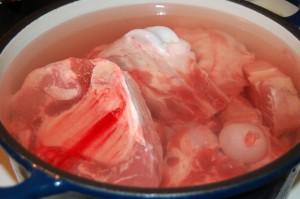

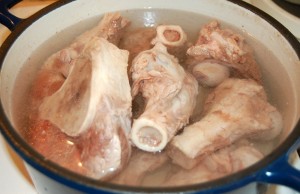
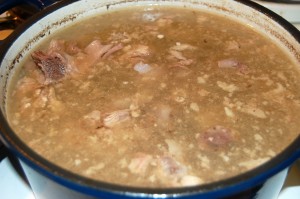
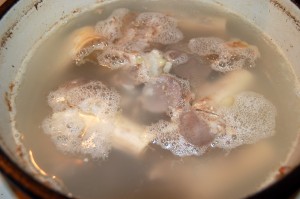
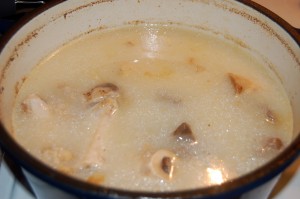
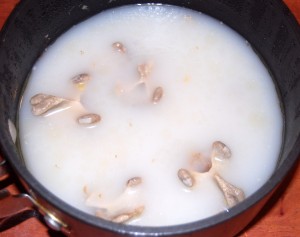
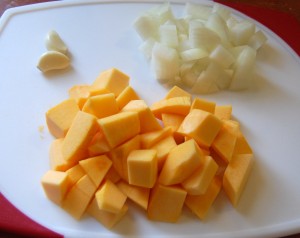
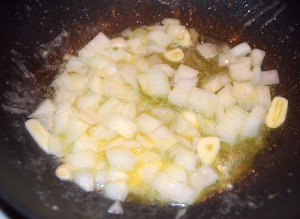
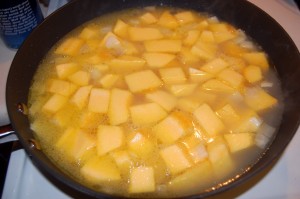
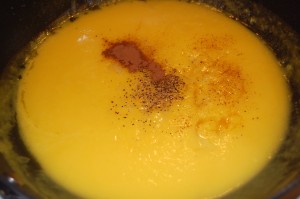
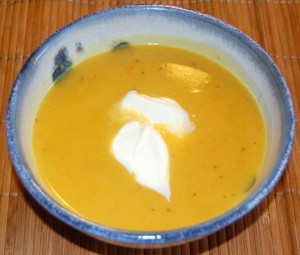




the gelatin Zeynel linked looks good should I get it?
A couple of folks told me to roast the beef bones at 400 degrees for 30 minutes before using them in the stock. Cover them with olive oil (which I have done and works well) or tomato paste – haven’t tried yet.
Removes the need to change the water and adds a nice flavor.
Hello Paul!
Hope you’re doing well. I was wondering if you had any thoughts on fish bones for bone broth in light of the Neu5gc post. Or should I just stick with chicken feet? I know you’re preparing further posts on the subject. I’m just curious if fish bones (from non fatty fish to avoid oxidized polyunsaturated fats) would be as rich in collagen and minerals as their land roaming counterparts.
Best to you and your family,
Nick
Fish bones are great.
Great thanks Paul!
The last broth I did I simmered for 40 hours… delicious.
I’m considering draining the broth after 24 hours for use, then cooling and freezing the bones for a week to repeat the process the following weekend.
Do you see any issue with freezing and reusing the bones once or twice?
i do several times and it always gel good
joanna
1 do several times and it always gel good, but i always use a fresh chicken with the beef bones
joanna
Hi Paul,
I made bone broth from about 2 lbs of grass fed bison and beef marrow… i cooked it for about 72 hours… but everytime i drink it in the morning, i feel sleepy and fatigued… Any ideas why? or do you know if this has happened to anyone, wondering if my broth is toxic?
thanks very much for any help!
Hi Paul
An article about health myths just popped up on Lifehacker and claims that collagen from bone broth doesn’t make it through the stomach acid.
Is this true?
http://vitals.lifehacker.com/six-myths-about-digestion-that-just-won-t-die-1710638420
Thanks much
It doesn’t matter if it gets digested because it’s still beneficial to get the raw materials from which collagen is made.
I cooked a turkey on Thanksgiving day (2015) and refidgerated bones for 5days. Then cooked bones for 24 hrs in crock pot. Refrigerated broth for 4 days.
At this point is it still OK to make soup and freeze the broth for future use?
Thanks,
Megs
Best thing is to smell it and see if it smells fresh. A lot depends on how sterile the pot was – if you transferred it to another container for refrigeration then it won’t be fresh; if you refrigerated it in the pot it was cooked in, then the pot will have been sterilized and it will last longer.
HI! I recently got a Greville Fast Slo Pro to make stock and it takes about two hours plus. What is your opinion of this method? Personally, I love it! Simmering for hours and hours is a little looooong!
I’m sorry, I made a typo, or Autocorrect did it for me 😡 I meant to say Breville. Yes, I just had to X out Greville 😐
Hi Paul, is there a recommended amount of pumpkin etc for the soup recipe? Is three Lbs of pumpkin a good amount?
We have been using the bone broth as the liquid to cook our rice – it’s an easy way to use it and makes the rice taste good.
Can the softened bones be chewed & eaten?
They could but I wouldn’t recommend it as you could overdose on calcium and phosphorus.
Why do you discard the liquid after the first hour? I have never done that. I have never read or been advised to do that. What is the point? Taste? Seems like you would be losing something by doing that.
My butcher mentioned that his mother always did a par boil to remove the top layer of dried fat or other bits that may be on the bones. I do a par boil, just like you might do with veggies, then roast the bones and then use and re-use with much better taste and a more clear broth.
Hope this is helpful in some way 🙂 Good cooking to you.
Hi Paul.
I live in Spain. I’ve tried to buy chicken feet to make broth, but I was told that the European Union does not allow chicken feet to be sold to the public 😯 . It seems that chinese immigrants are “allowed” to buy them because of their culture. It seems the chicken from feet are too dirty for the taste of our bureacrats. Strangely enough, people are allowed to buy and sell feet from bulls and cows, and their tails, which, to my knowledge, are potentially way more dirty than chicken feet. I think our EU overlords made a “cultural” exception because of, well, tradition. Which is also weird, because in Spain there has been a tradition for many centuries of making broth with the whole chicken (and hens, and partridges, and quails, and even doves and pidgeons), as can be shown by reading ancient literature. So, How come one tradition is respected and the other is not?
My guess is that they know that chicken from feedlots are very dirty and sick, and, because of the nature of lawmaking, they just made a blanket prohibition of all chicken feet, even “organic” chicken and traditionally raised poultry.
My question for you is: If you take the dirtiest chicken feet from the worst chicken farm and clean it very well and boil it for many hours, do you think such broth would be sterilized?
💡 I think I’ll try to disguise myself as a chinese man to see if I can buy some chicken feet. Weird times…
Yes, the broth would be fine. It is crazy to ban chicken feet. I searched online and didn’t see a European Union chicken feet ban – are you sure?
No, I’m not sure. But in my country it is really common for everyone (from electricians to doctors) to claim that they can’t do something because of someEU directive, which is very misleading if one has a bias to trust people.
There may be some kind of recomendation against chicken feet being sold to the general public, or some kind of unofficial bureaucratic frowning up, that in turn is understood by people as a full-fledged prohibition. I suspect what is really happening is that wholesalers prefer to sell the odd-bits to the manufacturers of dried cube bullions of broth. But I’m pretty sure that if making broth from chicken’s feet became fashionable, automagically all our newspapers and the TV news would be yelling that that’s a public health danger, and then politicians would then arise from their slumber to actually ban it.
To recap, it is probably false, but it could become true anytime. To illustrate this, I’ll add that there was a Government sponsored Solar Energy Plant that produced electricity in the night with gasoil generators… Spain is different!
Anyway, calves’ feet broth tastes good and it’s very gelatinous.
Thanks for your answer.
Miguel, instead of disguising yourself as a Chinese man, disguise yourself as a Chinese woman instead. If questioned, let them know that’s how
😉 you identify yourself and dare them to question it.’
Hahaha.
That’s a good one.
Hi, I just wanted to say I also live in Spain, in Madrid. A few weeks ago I saw chicken feet for sale in an Ahorra Mas supermarket… (maybe not the best place to be buying meat but anyway). Just wanted to let you know… 😉
WHY DO PEOPLE WANT CHICKEN FEET? I WAS TOLD WINGS ARE THE BEST,. I USE A WHOLE CHICKEN, CHICKEN BROTH AND COOK FOR 2 HRS. BEEF BONES I COOK LONGER, BEEF HAS MORE TO OFFER THEN CHICKEN. I AM SURE WHAT YOU ARE COOKING HAS A LOT TO OFFCER. CHICKEN FEET? NOTHING BUT SKIN.
I so love Pumpkin Soup and will try this recipe. Since I’ve often been busy, I tried drinking Au Bon Broth and experienced changes with my health almost instantly.
Hi Paul,
Is it safe to store the already simmered bones in the fridge between rounds of broth? After how long should the bones be discarded?
Thanks,
Ashley
It’s safe. (Updated with Shou-Ching’s advice.) They will last about two weeks. You can judge by smell. If you want to keep them longer, freeze them between uses.
Here are two interesting links about bone broths:
This study found that adding 20 ml of vinegar per liter of water (4 tsp per quart) and simmering for longer than 8 hours extracted higher amounts of calcium and magnesium from pork and beef bones. However, these amounts were still less than 5% of the daily recommended levels.
suggest that a long cooking time effectively extracts gelatin, and a bit of vinegar will not make any significant difference.
The links in my above post didn’t quite work right.
The first paragraph refers to the following study:
Essential and toxic metals in animal bone broths. (2017)
https://www.ncbi.nlm.nih.gov/pmc/articles/PMC5533136
The second paragraph should read:
This post and comments: https://cooking.stackexchange.com/questions/9866/how-can-i-increase-the-extraction-of-gelatin-and-minerals-from-bones-into-my-sto/9867#9867
suggest that a long cooking time effectively extracts gelatin, and a bit of vinegar will not make any significant difference.
Hi guys, I need to know a little bit more about the correct / healthy way to eat bone broth. I searched in the book (which I read and it’s fantastic, thank you) but I couldn’t find any info about how often should we consume it. I also am curious about if I should have it as it is or should I cook with it. I noticed that many people drink it without adding anything else and drink it on a daily basis.
My most important question is about how often should I drink it. Any advise? Isn’t it too concentrate and too strong to drink it daily? Isn’t that dangerous for the liver or pancreas?
I found this quote from Paul in an earlier post:
Paul Jaminet March 15, 2013 at 11:13 am
Hi Angela,
In addition to the bone broth, 3-7 bowls per week (be sure to include joint material for collagen/matrix)…
Hi Mircea,
Randy’s answers are great. The best guide to use is your own taste. If it tastes good, it is benefiting you; if you tire of it, you probably no longer need it.
Best, Paul
I also recall Paul saying trust your taste. Give it a rest if it stops tasting delicious.
My sense is you would have a hard time overdoing it.
Paul Jaminet March 15, 2013 at 11:13 am
Hi Angela,
In addition to the bone broth, 3-7 bowls per week (be sure to include joint material for collagen/matrix)